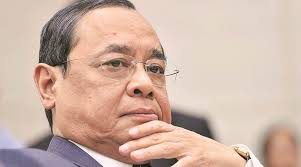If you want to know a quick answer of these questions, like who is Ranjan Gogoi? About Ranjan Gogoi, Biography of Ranjan Gogoi, history of Ranjan Gogoi, So please read our quick and short description about Ranjan Gogoi in below:
Chief Justice Ranjan Gogoi: Short Description about Ranjan Gogoi!
| Country | India |
| Full Name of Ranjan Gogoi | Ranjan Gogoi |
| Nick Name of Ranjan Gogoi | Ranjan Gogoi |
| Occupation | Justice |
| Born of Ranjan Gogoi | 18 November 1954 |
| Death of Ranjan Gogoi | – |
| Born Place of Ranjan Gogoi | Dibrugarh, Assam, India |
| Death Place of Ranjan Gogoi | – |
| Father of Ranjan Gogoi | Keshab Chandra Gogoi |
| Mother of Ranjan Gogoi | Shanti Priya Gogoi |
| Brothers of Ranjan Gogoi | Anjan Kumar Gogoi, |
| Sisters of Ranjan Gogoi | No |
| Married | Yes |
| Wife of Ranjan Gogoi | Rupanjali Gogoi |
| Son of Ranjan Gogoi | Raktim Gogoi |
| Daughter of Ranjan Gogoi | Rashmi Gogoi |
Detailed Description about Chief Justice Ranjan Gogoi:
Ranjan Gogoi is the Chief Justice (Chief Justice of India) of the Supreme Court. Ranjan Gogoi assumed an office on 3 October 2018. He has become the 46th Chief Justice of India. His term will last for about 13 months (17 November 2019). Magistrate Court, High Court and Supreme Court are three types of courts in our country, out of which the Supreme Court is considered as the largest justice temple in the country. The Chief Judge is also known as the Chief Justice of India, who is elected on the basis of seniority, The President administered the presidential oath.
The Supreme Court of India is located in New Delhi. Ranjan Gogoi is currently the Chief Justice, prior to this, Deepak Mishra was in this post. Gogoi is also the 46th Chief Justice of the country and the first Chief Justice of the country to come from East and Assam. India is said to be a country of unity in diversity in which Manmohan Singh as the former Prime Minister and the current Chief Justice are also from a small state.
Early life
Ranjan Gogoi was born on 18 November 1954 in Dibrugarh district of Assam. His father’s name was Keshav Chandra Gogoi and mother’s name was Shanti Gogoi. His father Keshav Chandra Gogoi was a lawyer and also a leader of the Indian National Congress. He has been an MLA from Dibrugarh assembly seat and was also the Chief Minister of Assam for some time. His tenure was from 13 January 1982 to 19 March 1982 (total of 66 days).
Anjan Kumar Gogoi, the elder brother of Justice Ranjan Gogoi, has served in the Indian Air Force. He has a child named Raktim Gogoi who is also in the profession of advocacy.
Career of Ranjan Gogoi
Gogoi’s initial education took place in Don Basco and after that he came to Delhi. He studied his undergraduate degree in history from St. Stephen’s College and further got a law degree from Delhi University.
From 1978, he started practicing in Guwahati Court Bar. In 2001, in the same court, he was made as the Chief Justice and later he was transferred to the Punjab Haryana Court, after promotion Gogoi got the responsibility as the Judge of the Supreme Court of India and after the resignation of Deepak Mishra, Gogoi Became Chief judge
Justice Gogoi’s name came up for discussion across the country when he held a press conference along with three other senior-most judges of the Supreme Court. At that press conference, the Chief Justice Deepak Mishra’s attitude on the allocation of cases to certain benches was criticized. This was the first time in the history of the Indian judiciary.
Justice Ranjan Gogoi was one of the 11th Supreme Court judges who made their assets public. According to his declaration, he had no personal car of his own.
Controversy related to Ranjan Gogai:
Supreme Court Judge and Chief Justice Ranjan Gogoi has been surrounded by controversies many times during his career. Ranjan Gogoi first got involved in controversy when Ranjan Gogoi changed the High Court verdict in the case of the death of a woman who was raped by a train in Kerala in 2011. In Kerala, a woman was raped by a man and thrown from the train. On which the High Court was sentenced to death.
But Ranjan Gogoi’s bench changed it to life imprisonment. For which he was criticized by many social organizations. At the same time, former Justice Markandeyu Katju also criticized him by writing an article.
Apart from this, you remembered that press conference of four judges last year. Which shook the whole country. For the first time in history, four judges of the Supreme Court held a press conference and criticized the Chief Justice. These four judges also included Ranjan Gogoi, who accused the Chief Justice of misusing his right to be the Master of the Roster of the Supreme Court in the allocation of cases.
Important decisions of Ranjan Gogai:
Ranjan Gogoi is a part of the bench of the Supreme Court who ordered the details of the assets, education and all the ongoing cases of the candidate in the elections. Apart from this, the decision of Mumbai High Court was also rejected by Ranjan Gogoi. In which an actor Amitabh Bachchan was accused of paying 1.66 crore tax less than the earnings made from Kaun Banega Crorepati season 2002-03.
The National Register of Citizens will be one of the major decisions in the life of Gogoi. The Supreme Court is hearing recently. In 2017; a writ petition was filed in the Supreme Court in connection with the identification of the original residents and illegal occupants through the NRC in the state of Assam.
Historical decision came on Ayodhya verdict
The judgment in the Ayodhya case has been delivered by the constitution bench headed by Supreme Court Chief Justice Ranjan Gogoi. Let us know what happened in this case.
A constitutional bench headed by the Chief Justice had heard this sensitive matter for 40 consecutive days. The hearing, which began on 6 August, lasted till 16 October. On 16 October, the bench reserved the decision. In the Constitution bench, Justice SA Bobde, Justice DY Chandrachud, Justice Ashok Bhushan and Justice S.K. Abdul Nazir was also included.
The Chief Justice Ranjan Gogoi is retiring on November 17. Before this, he has recorded his name in the pages of history by giving this decision.
Hearing on 14 appeals: The Allahabad High Court gave its verdict on September 30, 2010 on four civil cases on 2.77 acres of land in Ayodhya. The High Court had ordered the land to be divided into three equal parts between Ram Lala, Nirmohi Akhara and Sunni Waqf Board, against which all the parties had filed a total of 14 appeals in the Supreme Court.
Initially five cases were registered: Five cases were initially registered in the lower court in this dispute. In 1950, the first case was filed by Ram Lala’s devotee Gopal Singh Visharad. The same year, Paramhansa Ramchandra also filed a lawsuit urging permission to continue the puja and keep Ram Lala in the main dome. There is no longer a dome structure. He later withdrew his case.
Nirmohi Akhara became party in 1959: Nirmohi Akhara filed a lawsuit in 1959 demanding the right to right and worship on 2.77 acres of land. After this, in 1961, the Uttar Pradesh Sunni Central Waqf Board also filed a lawsuit and asserted its right on the disputed land.
Case filed in 1989 on behalf of Ram Lala Virajaman: On behalf of the deity ‘Ram Lala Virajman’, former judge of the Allahabad High Court, Devki Nandan Agarwal and Janmabhoomi filed a case in 1989 seeking ownership of the disputed land.
